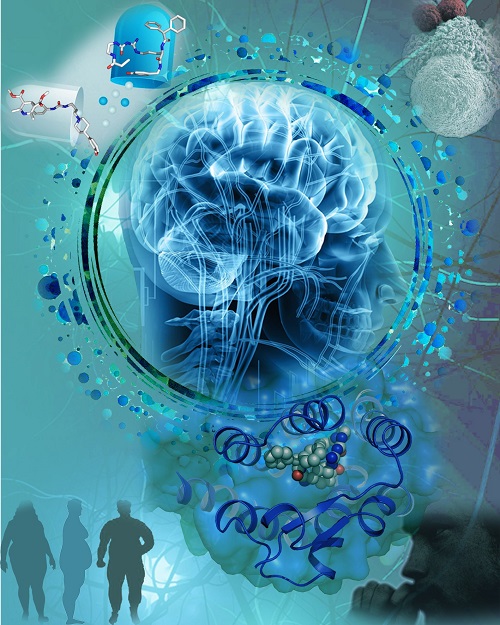Neuropeptide Y Y1 Receptor Structures Offer New Opportunities for Anti-obesity Drug Discovery
-Structures of human neuropeptide Y receptor Y1R reveal drug recognition mechanisms
Obesity is a major public health concern with over 10% obese people globally. Each year, millions of people die from obesity related diseases, such as diabetes and cardiovascular disease. Neuropeptide Y (NPY) is a highly abundant neuropeptide in central nervous system and participates in a variety of physiological activities, including appetite, energy homeostasis and vascular construction.
Four different neuropeptide Y receptors, namely Y1, Y2, Y4 and Y5 receptors, have been identified in human. NPY is the most powerful stimulant of food intake and this effect is primarily mediated by the Y1 receptor (Y1R). Thus, Y1R serves as an important drug target for many human diseases, such as obesity, type 2 diabetes and metabolic syndrome. However, the clinical usage of Y1R ligands has been hampered by low potency and selectivity, poor brain penetration ability or lack of oral bioavailability.
Recently, scientists from the Shanghai Institute of Materia Medica (SIMM), Chinese Academy of Sciences (CAS), in collaboration with several groups based in Germany, United States, China and Sweden, determined the high-resolution atomic structures of human Y1R bound to two structurally diverse antagonists UR-MK299 and BMS-193885, providing a detailed molecular map of Y1R and invaluable insights into understanding the pharmacology of NPY receptors. The study was published online in Nature on April 18, 2018 (18:00PM, London time) titled “Structural basis of ligand binding modes at the neuropeptide Y Y1 receptor”.
The Y1R structures reveal, for the first time, the molecular details of a NPY receptor binding to its ligand at atomic level, and provide an accurate template for drug design targeting Y1R. The structures combined with mutagenesis, ligand binding and signaling studies elucidate the binding modes of Y1R to various antagonists and the molecular mechanisms of ligand selectivity in different NPY receptors. These findings offer new opportunities for anti-obesity drug discovery.
The NPY-Y receptor system is one of the most complex networks for a GPCR family with three peptide ligands (NPY, peptide YY and pancreatic polypeptide) binding to four receptors with different affinity and selectivity. Based on the Y1R structure, the researchers performed extensive studies including complementary mutagenesis, cell signaling, nuclear magnetic resonance, molecular docking and photo-crosslinking.
The results provide insights into the binding behavior of the endogenous agonist NPY to Y1R, and for the first time identified the binding site of NPY N terminus, which is critical for receptor selectivity, in Y1R. These insights into Y1R expand our understanding of NPY receptor signal transduction and lay a foundation for carrying out structure-based drug discovery that targets this physiologically important receptor.
“The Y1R structures and our functional studies help us understand how this receptor bind to different types of ligands with molecular details. This can enable development of new anti-obesity drugs with better selectivity and efficacy.” said the team leader and SIMM professor Dr. WU Beili.
In addition to Dr. WU, other notable investigators included Dr. ZHAO Qiang, Dr. YANG Zhenlin and Dr. HAN Shuo from SIMM, Dr. Armin Buschauer and Dr. Max Keller from University of Regensburg, Dr. Annette G. Beck-Sickinger, Dr. Daniel Huster and Dr. Annette Kaiser from Leipzig University, Dr. Jens Meiler and graduate student Brain J. Bender from Vanderbilt University, Dr. Raymond Stevens from the iHuman Institute of ShanghaiTech University and Dr. ZHANG Rongguang from Institute of Biophysics, CAS. The study was funded by Chinese Academy of Sciences, the National Science Foundation of China, the European Community, the Free State of Saxony (Germany), the Deutsche Forschungsgemeinschaft (DFG), National Institute of Health (U.S.A.) and National Science Fundation (U.S.A.).
Link to the article: https://www.nature.com/articles/s41586-018-0046-x

Figure: The crystal structure of Y1R binding to an antagonist UR-MK299. The receptor is shown in blue cartoon and surface representations. The antagonist UR-MK299 is shown as grey spheres. (Image courtesy of Dr. WU Beili’s group from SIMMCAS)
Contact person:
Prof. WU Beili
Email: beiliwu@simm.ac.cn

